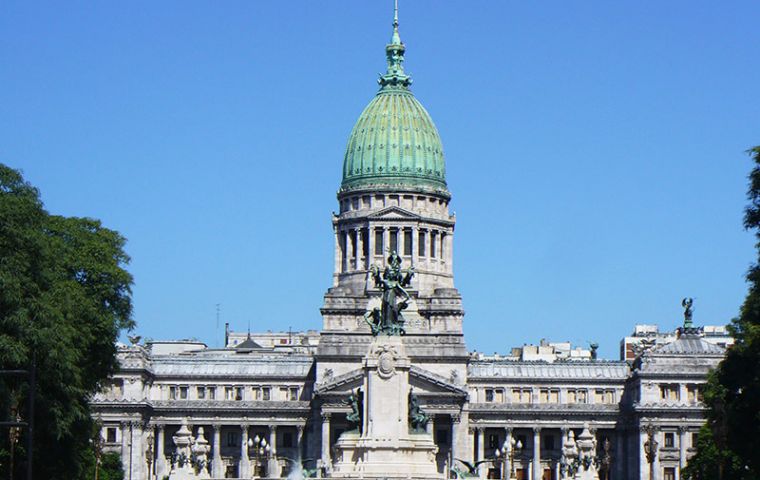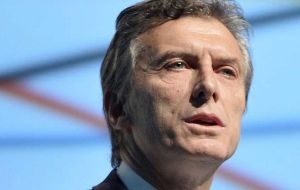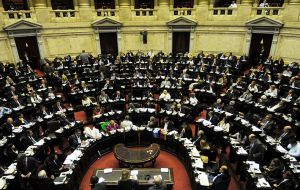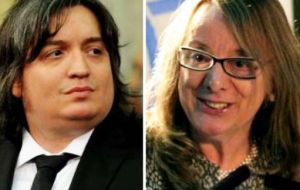MercoPress. South Atlantic News Agency
If Scioli is Argentina' next president he should have a strong support in Congress
 Boasting 113 seats in the Lower House, a total of 77 FpV lawmakers will contest their places during the general election
Boasting 113 seats in the Lower House, a total of 77 FpV lawmakers will contest their places during the general election  The second-largest party in the Lower House, Radical party, will contest 13 of its 35 seats, and candidate Macri's PRO, just four of its 18 seats
The second-largest party in the Lower House, Radical party, will contest 13 of its 35 seats, and candidate Macri's PRO, just four of its 18 seats  Stakes in the upper house of Congress (72 seats) are due to be less high, with one third of the seats in the Senate set to be voted on at the general election in two
Stakes in the upper house of Congress (72 seats) are due to be less high, with one third of the seats in the Senate set to be voted on at the general election in two  Among the likely new lawmakers are Economy Minister Axel Kicillof, a protégé of Cristina Fernandez who topped FpV lists of lawmakers in Buenos Aires City
Among the likely new lawmakers are Economy Minister Axel Kicillof, a protégé of Cristina Fernandez who topped FpV lists of lawmakers in Buenos Aires City  In Santa Cruz province the president’s son Máximo Kirchner is running for the Lower House and sister in law Alicia Kirchner is for governor of the province.
In Santa Cruz province the president’s son Máximo Kirchner is running for the Lower House and sister in law Alicia Kirchner is for governor of the province. Next October 25 Argentines will be voting for a new president but also to renew half of all seats (257) in the Lower House and one third of seats in the Senate. This means that more than fifty percent of the 130 seats available currently belonging to the ruling Victory Front (FpV) of Cristina Fernandez as the “first minority” within the legislature, will be disputed.
Boasting 113 seats in the Lower House, a total of 77 FpV lawmakers will contest their places during the general election, which they have held since President Cristina Fernández stormed to victory in the first round of the 2011 presidential race with an overwhelming 54% of the vote.
The stakes are generally lower for the other parties represented in the legislature.
The second-largest party in the Lower House, the Radical (UCR) party, will contest 13 of its 35 seats this month, while the PRO, led at the national level by Let’s Change presidential candidate and outgoing mayor of Buenos Aires City Mauricio Macri, has just four of its 18 seats in the Lower House open at the election.
Meanwhile, the dissident Peronism of presidential candidate Sergio Massa’s party, the Renewal Front (FR), will contest five seats, a third of its total of 15, and fellow presidential rival Margarita Stolbizer’s own GEN progressive coalition places three of its four Lower House seats on the line at the election.
Interestingly the make-up of the Argentine Lower House in 2016 is set to host various key players currently holding ministerial positions in the ruling Cristina Fernandez administration.
Among those is likely to be Economy Minister Axel Kicillof, a protégé of the president, who topped the FpV lists of lawmakers in Buenos Aires City at the presidential PASO primaries on August 9.
Also expected to win seats in the lower house are Federal Planning Minister Julio de Vido and Eduardo “Wado” de Pedro, who is set to make a return to Congress after completing his term as presidential Chief-of-Staff.
Outgoing governor of Buenos Aires province Daniel Scioli, the FpV presidential candidate and firm frontrunner in the race to win on 25 October also has allies expected to reach places in the new Congress, including Cristina Álvarez Rodríguez, the current Government Minister of the country’s largest district.
Elsewhere within the FpV ranks, attention will be drawn to the prospective representatives from Patagonian Santa Cruz province, where the president’s own son Máximo Kirchner heads the lists of FpV candidates competing for spots in the legislature and her sister in law Alicia Kirchner (ex president Nestor Kirchner's sister) is running for governor of the province.
Stakes in the upper house of Congress (72 seats) are due to be less high, with one third of the seats in the Senate set to be voted on at the general election in two weeks time, to 24 seats from eight provinces in total, namely Catamarca, Chubut, Córdoba, Corrientes, La Pampa, Mendoza Santa Fe and Tucumán.
The ruling FpV currently enjoys a plurality in the Senate, and with many of the available 24 seats belonging to opposition candidates from the UCR, FR and PRO, if the FpV’s results in the August 9 primaries are repeated on October 25, it would maintain this quorum in the upper house comfortably.
Consequently, were Scioli to be elected to the presidency, he would consequently face little trouble passing legislation through the Senate.




Top Comments
Disclaimer & comment rules-

-

-

Read all commentsMay your God help you Argentinians, you will need faith.
Oct 14th, 2015 - 10:37 am 0God another Peronist to further mess up Argentina.
Oct 14th, 2015 - 01:43 pm 0Whoever the next President is, they have a shitpot to deal with:
Oct 16th, 2015 - 01:56 am 0The deficit has increased 30% a year since the last surplus in 2008. And inflation; it hovers anywhere from 25% to 40% a year since.....the 90s. Couple that with over valued currency and this shitpot starts to smell across the continent. Of course over valued currency and inflation is rooted in the restriction on imports. Fine when they exports but the surplus consistently decreased from a high of 12 billion in 2001 to less than 1 billion this past year. All these factors combine for the perfect storm in the reserves. The only reason it's as high as 28 billion is the 11 billion they borrowed in swaps with China. Still needs to be paid back. Lets look at the reserves:
Over 7 billion in unpaid imports
11 billion to China
7.5 billion in private deposits
1.6 billion due to France
Mmmmmm 7 + 11+7.5 +1.6+27.1 billion in earmarked reserves. Does anyone recall what the Kirchner regime claimed to have? Deduct that from it. Last week Argentina made a 5.9 billion bond payment and claimed to have had 33 billion in reserves. 33 -5.9 leaves 27.1. Oops.......I see a problem. The new issues are going nowhere and they have no money.
yeah.........Scioli takes over and it is going to be a real wakeup call for the people. A day late and a dollar short.
Macri gets in and it will be a .....see we told you not to vote for him from the Kirchner's. Unless he can work something with the assholes singer et al. Funny thing, the Kirchner's have the camp sabotaging the electrical grid in the working class areas in a feeble attempt to get them to turn on Macri.
Either way, Argentina is now actually at a point of no money. China may roll the swaps enabling a small breath of life. But in reality that is merely life support to the brain dead. With El Nino gearing up for a 60 year peak, they won't have to use the camp to sabotage anything, nature will do it.
Argentina, wake up and change your system.
Commenting for this story is now closed.
If you have a Facebook account, become a fan and comment on our Facebook Page!